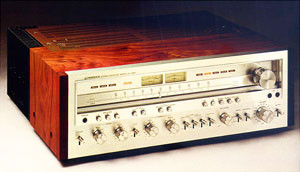The Pioneer SX-1250, an AM/FM stereo receiver produced between 1976 and 1978, stands as a testament to an era when audio quality and robust engineering were paramount. This receiver wasn’t just another piece of audio equipment; it was a statement, a declaration of Pioneer’s commitment to pushing the boundaries of sound reproduction. For audiophiles and vintage hi-fi enthusiasts, the Pioneer SX-1250 remains a highly sought-after piece, celebrated for its powerful performance, exceptional build quality, and warm, engaging sound.
Unveiling the Pioneer SX-1250: A Glimpse into Audio History
In the mid-1970s, the hi-fi industry was fiercely competitive, with manufacturers vying to create the most powerful and best-sounding receivers. The Pioneer SX-1250 emerged as a frontrunner in this “receiver wars” era. Pioneer designed this unit to not only meet but exceed the demands of discerning listeners. They emphasized superior FM tuner performance, ensuring crystal-clear radio reception alongside robust amplifier capabilities. The promotional materials of the time posed compelling questions to potential buyers, urging them to consider if a receiver guaranteed high performance in FM reception, incorporated the latest circuit technology for stable sound, and offered lasting pride of ownership. The Pioneer SX-1250 confidently answered “yes” to all, setting a high bar for its contemporaries.
 Pioneer SX-1250 Front Panel
Pioneer SX-1250 Front Panel
Engineering Marvel: Specifications and Performance
The specifications of the Pioneer SX-1250 speak volumes about its engineering prowess. Boasting a power output of 160 watts per channel into 8 ohms in stereo mode, this receiver delivered ample power to drive even demanding loudspeakers. Its frequency response, spanning from 10Hz to 50kHz, ensured a wide and accurate reproduction of the audio spectrum. A low total harmonic distortion of just 0.1% promised clean and faithful sound amplification. The damping factor of 30 indicated good control over speaker cones, contributing to tighter and more defined bass. Furthermore, the input sensitivity figures for phono (MM), microphone, and line inputs demonstrated its versatility in accommodating various audio sources. These technical details underscore the Pioneer SX-1250‘s design philosophy: to deliver uncompromised audio fidelity and power.
The physical dimensions and weight of the Pioneer SX-1250 further highlight its robust construction. Weighing in at a substantial 29.2 kg and measuring 556 x 186.5 x 464.5mm, this receiver was built like a tank. This heft was not just for show; it reflected the quality of components used, including massive heat sinks to ensure stable operation even at high power levels. This solid build contributes to the unit’s longevity, a key factor in its enduring appeal among vintage audio collectors.
Why the SX-1250 Still Resonates Today: User Reviews and Legacy
Beyond the specifications, the true measure of the Pioneer SX-1250‘s greatness lies in the experiences of those who have owned and listened to it. User reviews consistently praise its exceptional sound quality, powerful performance, and enduring reliability. One reviewer, Rod Vargas, stated, “The SX1250 is superior in every way” even when compared to the higher-end SX-1980, highlighting its “warmth of sound, ease of serviceability, beauty and…just the right size.” This sentiment of superior sound and user-friendliness is echoed by many.
Another long-term owner, Wiley, who has had his Pioneer SX-1250 for 43 years, noted its unwavering performance and even improved sound after a restoration, stating it now tests at an impressive 198 watts per channel. The ease of repair and availability of service manuals, as indicated by numerous downloadable resources on platforms like HiFi Engine, further contribute to its appeal for vintage audio enthusiasts who value maintainability. The recurring theme in reviews is clear: the Pioneer SX-1250 is not just a receiver; it’s an “end game receiver,” a “genuine audio masterpiece” that continues to deliver exceptional listening experiences decades after its original release. Its “warm tubelike sound,” as described by suitekids, captures a sonic signature that many modern receivers struggle to replicate, reinforcing its legendary status in the world of hi-fi audio.


